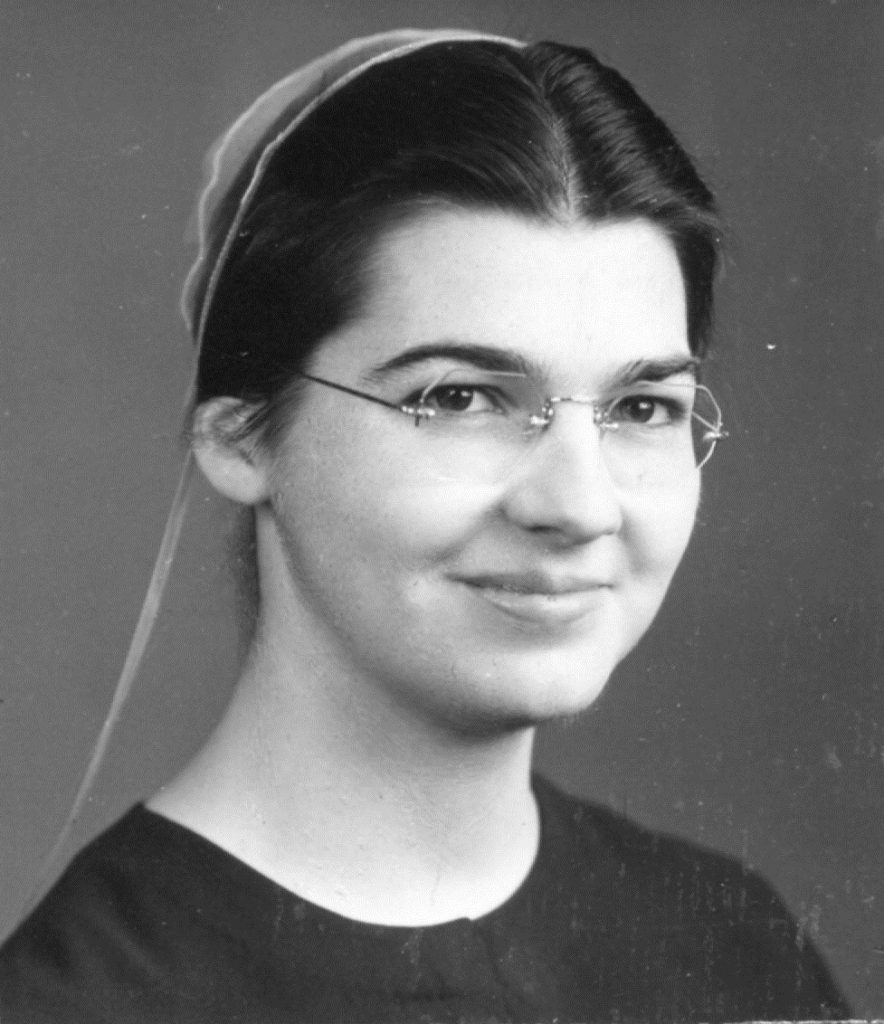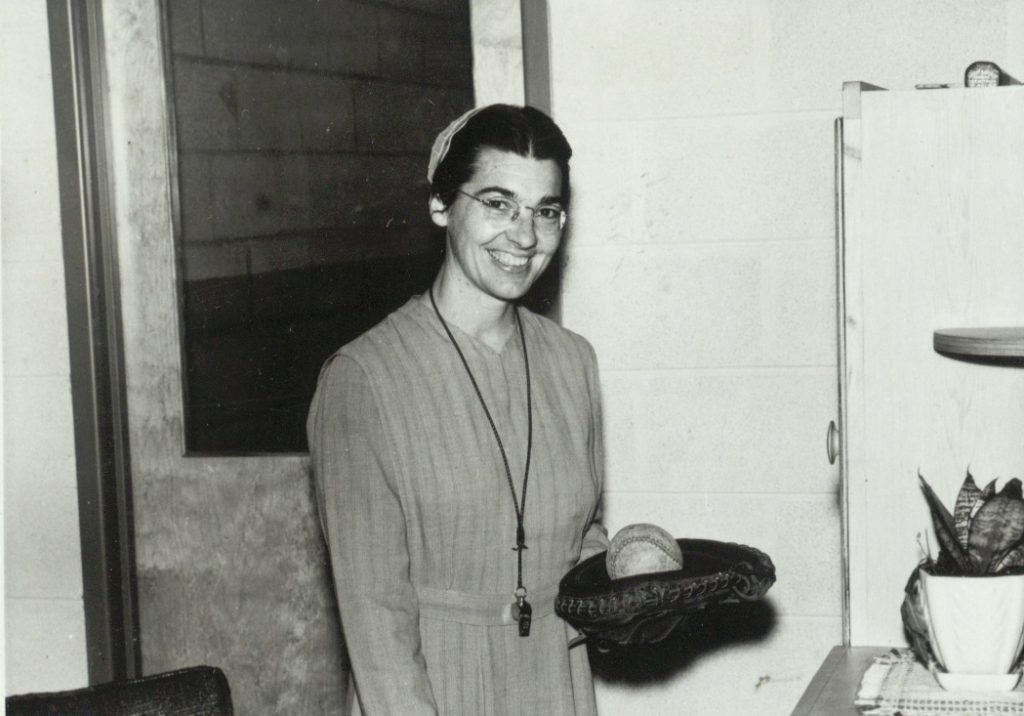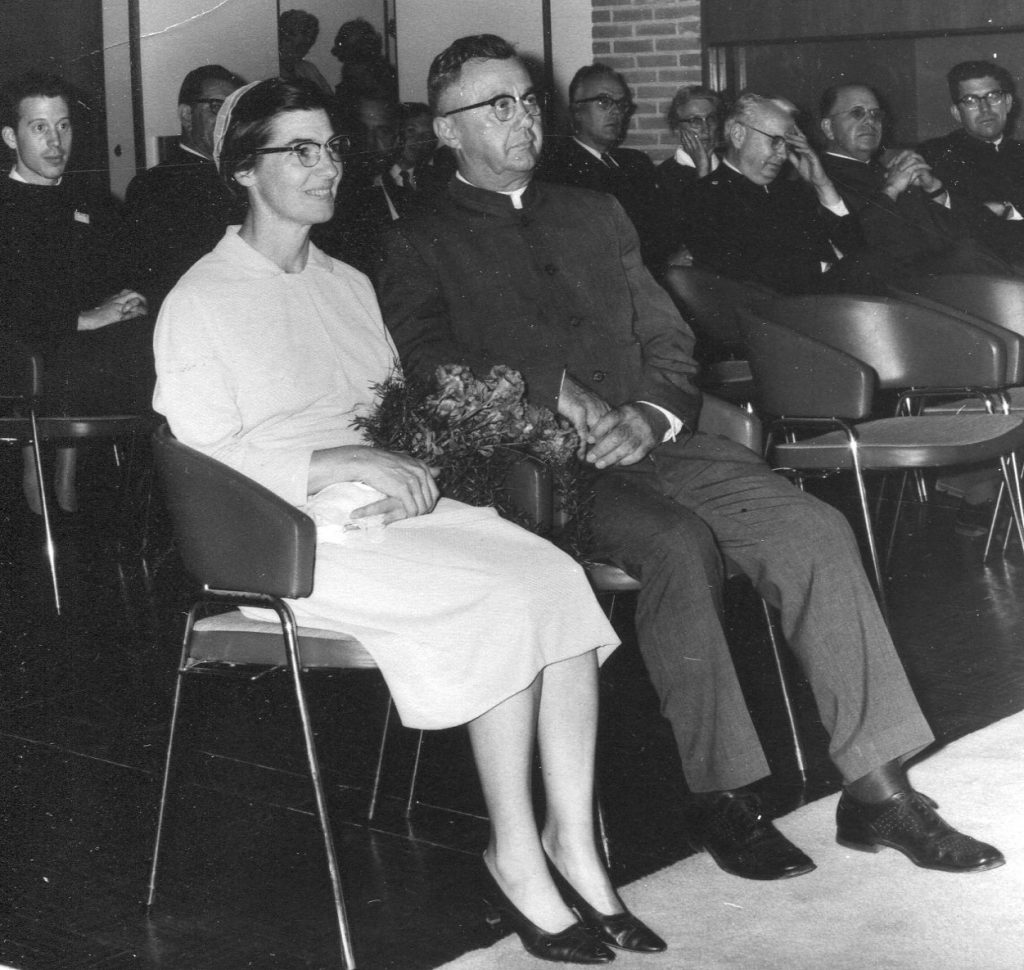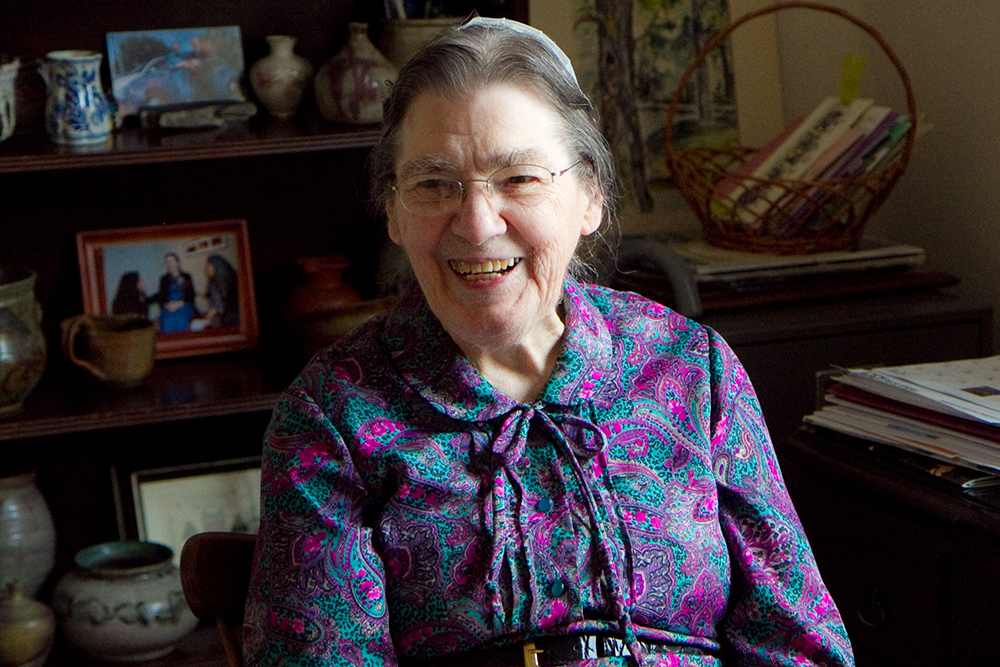Dr. Margaret Martin Gehman, among the first female graduates from Eastern Mennonite College to earn a doctorate and a professor of art and physical education at the university for nearly 50 years, modeling an independent spirit and zest for life to generations of students, died Aug. 28, 2019, at Virginia Mennonite Retirement Community. She was 97.

Gehman taught art and physical education from 1944-87, and continued to teach a watercolor class through 1996. She is among EMU’s most generous philanthropists, establishing an endowed scholarship fund to support art and physical education majors as well as program endowments for athletics, the humanities and special buildings on campus. The Margaret Martin Gehman Art Gallery in EMU’s University Commons is named in her honor. [Read more about her 2010 donation to EMU of a 1967 “family heirloom” Volkswagen Beetle, purchased in Europe at the time of her marriage to Professor Ernest Gehman.”]
In 2005, EMU established the Margaret Martin Gehman Philanthropy Award to honor Gehman and, in subsequent years, others who exemplify her legacy of generosity and selfless service to others.
A memorial service will be Saturday, Sept. 28, 2019, at 2 p.m. at Park View Mennonite Church, 1600 College Ave., Harrisonburg. The family will receive friends before and after the service. In lieu of flowers, memorial contributions may be made to The Margaret Martin Gehman Endowed Scholarship ℅ EMU, 1200 Park Rd. Harrisonburg, Va., 22802 or the VMRC Foundation, Good Samaritan Fund, 1491 Virginia Ave., Harrisonburg, Va., 22802.
Those wishing to share memories of Dr. Gehman are welcome to visit the comment box at the end of this article (all entries will be shared with the family) or to visit the online registry at www.mcmullenfh.com.
***
Margaret Gehman was born May 24, 1922, in Hagerstown, Maryland. The daughter of the late J.D. Earl Martin and Edna (Cunningham) Martin, her aptitude for learning and spirit emerged during early days in a two-room elementary school. Unusually for the time, she attended the public junior high and was among just three conservative Mennonite students during her first two years at Hagerstown High School.
“I wasn’t the typical person to follow the routine of what everyone else was doing,” she said in a 1992 interview with Nate Yoder, retired professor of church history and former university archivist, who was then collecting background information for his doctoral dissertation on Mennonite conservatism in higher education. [Much of the information that follows is drawn from Yoder’s recording, now in his personal collection.]
Gehman then graduated high school at Eastern Mennonite School and continued for a further two years, graduating in 1942. [EMS was a two-year college at the time.] She taught in area public schools for two years, eventually returning to nearby Madison College to earn a degree in 1945. The next academic year, Gehman accepted a full-time teaching position at Madison, but was also approached with a part-time opportunity at EMS, teaching physical education and assisting in the biology labs. She juggled both positions until committing full-time to EMS. The next years were busy ones, as she spent winter terms and summers earning an MS degree at George Peabody College for Teachers (now Vanderbilt University),

Along with teaching and her own educational pursuits, Gehman provided leadership to a number of church, youth and work camps — and led four American Youth Hostel tours — in the United States and Europe. She was a member of Morning View Mennonite Church, where she taught Sunday School.
Around campus, she was known for her energy and enjoyment of physical activities, and particularly for her swiftness. “Speedy” was her nickname, coming in part from her introduction of the game of speedball to students, but also because the adjective described her on the move.

About her diverse intellectual affinity for art and physical education — “and for a time, I thought I might teach some math” — Gehman commented that “a lot of people found it mighty queer, but really, it was very good.” For the rest of her life, she was devoted to both, even declaring an art minor while working on her EdD degree, where she was the only woman in her doctoral class.
As one of the few women in the entire school and the only one to wear a head covering, she drew attention from her peers, many of whom were coaches and proponents of sports competition and intercollegiate athletics. Peabody at the time was especially strong in dance, which Gehman also did not condone. Though she voiced her concerns and represented her faith, she also listened and learned, and was often asked to share her perspectives in class and during social events. She appreciated, too, the opportunity to witness.
“I wasn’t good,” she reflected, “but the good there is is Christ in me…There was something that came through in my Christian witness and testimony…Really, some people feel to be so different was a hindrance. To me, it was a wonderful experience to have the opportunity to witness and to share. I guess because it didn’t bother me to be different, I could just be myself and people appreciated it, and I could stand up about ethical things.”
Gehman earned her doctorate in 1962, completing her dissertation on the history and development of physical education in Mennonite colleges in the United States, with special attention to Goshen, Hesston and EMC. The topic wasn’t her first choice, she said later, but was one of interest to her dissertation committee.
In 1967, after what she called “a good, rich single life,” she married a fellow professor, the widower Ernest Gehman, while both were attending Mennonite World Conference in the Netherlands. The EMC choir serenaded them at the ceremony.

Gehman, a professor of German, had as many varied intellectual interests as his wife. A cartoonist for The Sword and Trumpet, he was staunchly conservative.
Of their 22-year marriage, which lasted until Ernest’s death in 1988, she reflected, “The Lord gave us many good years and many good experiences together. He added so much depth and so much widening experience … and love is wonderful.”
An accomplished watercolorist and potter, she donated many of her works to charity. After her retirement, she enjoyed volunteering at EMU, VMRC, Media Ministries, her church and other agencies.
She is survived by her stepchildren, Huldah Claude of Wilmington, North Carolina; Rachel Metzler (James) of Sarasota, Florida, and Dr. John Gehman (Joy) of Crewe, Virginia. She is also survived by 21 step grandchildren, 27 step great-grandchildren, 3 step great-great grandchildren, and eight nieces and nephews.
In addition to her husband and parents, she was preceded in death by her brothers Earl Martin Jr. and Donald Martin, and her sister Betty Kniss. She was the last surviving member of her immediate family. She was also preceded in death by stepsons Daniel Gehman and David Gehman.

Dr. ‘Speedy’ Martin Gehman – what a remarkable woman! Never had her for a course during my years at EMC/EMU (1963-67) but saw her moving briskly around campus often. In my retirement, I would almost literally run into her regularly at the VMRC Wellness Center. She may have slowed down a tad, but she hadn’t aged a bit as far as her vivacious spirit and mental alertness was concerned (and as far as I know, she didn’t dye her hair, which remained black and intact!). Margaret would have had every right to ‘disown’ the very place she gave so many years of her life, given all the change on campus, but she remained steadfastly supportive, especially with her philanthropic spirit, to the end. Rest in peace, Speedy, although I can’t picture you resting for long, even in eternity.
Glad to see the link to the article in the tribute article above of the donation of her ’67 VW Beetle to EMU . . . it’s my all-time favorite news feature I ever wrote during my long years (40) as public information officer. I had a chance to purchase the ‘bug’ after it was completely restored but lacked the $$. Hope it wound up in a good home.
Dr. Margaret Martin Gehman was a longtime colleague of my father, Dr. Harold Lehman. Together they ran the physical education program at EMC in its early years. My father always spoke highly of their collaboration–repeating this to me in a telephone call as recently as a few weeks before his death on August 25. Intriguing that Dr. Gehman and Dr. Lehman passed away peacefully at VMRC within three days of each other–one at 97 and the other at 98. Perhaps physical education and fitness pays off after all!
She was a wondeful lady. She was a blessing for everyone. I studied PE under her for one half year at EMC(U). I also taught some of her nieces and nephews when I worked at Paradise Mennonite School in Hagerstown.
Although I don’t remember her personally, Margaret Gehman was a name I heard a lot around home. She was a collaegue and friend of my parents Irvin B. Horst and Ava Rohrer, who both taught at EMC. I was delighted to see them both sitting together in background of the wedding photo at the MWC in Amsterdam in ’67.
Dr. Gehman/Speedy is a true EMU legend. She represented so much of what the community values. I spent 17 years at EMU as a faculty member, athletic coach and VP of Student Life. Dr. Gehman was always supportive of me personally and professionally. Grateful to have known this amazing woman! She was one of a kind. Rest In Peace Speedy.